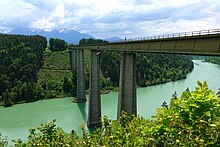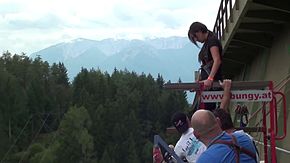Jauntalbahn
| Jauntalbahn | |||||||||||||||||||||||||||||||||||||||||||||||||||||||||
|---|---|---|---|---|---|---|---|---|---|---|---|---|---|---|---|---|---|---|---|---|---|---|---|---|---|---|---|---|---|---|---|---|---|---|---|---|---|---|---|---|---|---|---|---|---|---|---|---|---|---|---|---|---|---|---|---|---|
| Route number : | 410 01 | ||||||||||||||||||||||||||||||||||||||||||||||||||||||||
| Course book route (ÖBB) : | 620 | ||||||||||||||||||||||||||||||||||||||||||||||||||||||||
| Route length: | 20 km | ||||||||||||||||||||||||||||||||||||||||||||||||||||||||
| Gauge : | 1435 mm ( standard gauge ) | ||||||||||||||||||||||||||||||||||||||||||||||||||||||||
| Top speed: | 120 km / h | ||||||||||||||||||||||||||||||||||||||||||||||||||||||||
| Dual track : | single track connection | ||||||||||||||||||||||||||||||||||||||||||||||||||||||||
| state | Carinthia | ||||||||||||||||||||||||||||||||||||||||||||||||||||||||
|
|||||||||||||||||||||||||||||||||||||||||||||||||||||||||
The Jauntalbahn is an Austrian railway line in Carinthia . The 20 km long single-track connection leads from Bleiburg from the old Carinthian Railway to St. Paul an der Lavanttalbahn . The Jauntalbahn was built as the first Austrian new line after the Second World War , because after 1919 the original connection ran via Dravograd (Unterdrauburg) in Yugoslavia .
history
As early as 1919, the government promised to open up the region in Lower Carinthia, which was disadvantaged by the assignment of territories after the First World War, through an inner-Austrian railway line. This should revitalize the economically disadvantaged region.
Construction began in 1959. It took until October 10, 1964 before the line could be put into operation. The Jauntalbahn not only saved a great deal of time, but also made it more economical to operate, as trains could be run continuously from Zeltweg to Klagenfurt via Bleiburg . Above all, however, the opening of the Jauntalbahn by Federal President Adolf Schärf was the fulfillment of a long-cherished demand of the population.
For future use as a feeder line to the Koralm Railway , it was decided in 2014 to electrify section 81,703–90,688 and build an electronic signal box in Bleiburg station.
Route
The 19.070 km long Jauntalbahn branches off at kilometer 66.37 of the Lavanttalbahn in the St. Paul train station in Lavanttal . The kilometering was not restarted, but taken over by the Carinthian Railway from Bleiburg (descending). South of the St. Paul train station, the Jauntalbahn bends in a wide arc to the west and passes through the Johannesberg tunnel (480 m long) into the Granitztal. Through the Langenberg tunnel (1443 m long), the railway reaches the Jauntal at Eis-Ruden . The construction of both tunnels took place under difficult geological conditions.
The outstanding building in the Jauntalbahn is heeled at km 76.41 Jauntal . This is 430 m long and with a height of 96 m above the water level of the Drava one of the highest railway bridges in Austria. The bridge was built in collaboration between VOEST and Waagner-Biro .
There is also a footpath on the bridge from which bungee jumping has been possible since 1991 .
At Bleiburg , the Jauntalbahn joins the former Carinthian Railway ( Maribor / Marburg a. D. Drau - Villach ).
Web links
- Current timetable of the ÖBB .
- Images of the tunnel portals
- The Jauntalbahn
literature
- Dietmar Rauter, Herwig Rainer: Off the beaten track: The Lavanttalbahn Zeltweg - Wolfsberg - Unterdrauburg - Wöllan - St. Paul - Bleiburg (Jauntalbahn) . Wolf Verlag, Wolfsberg 1999. ISBN 3901551395
Individual evidence
- ↑ Submission project "Bleiburg Loop - Package of Measures III". bmvit , accessed on February 17, 2016 .
- ↑ General Directorate of the Austrian Federal Railways (ed.): Almanach der Österreichische Eisenbahnen 1966 . Vienna 1966, page XIX


